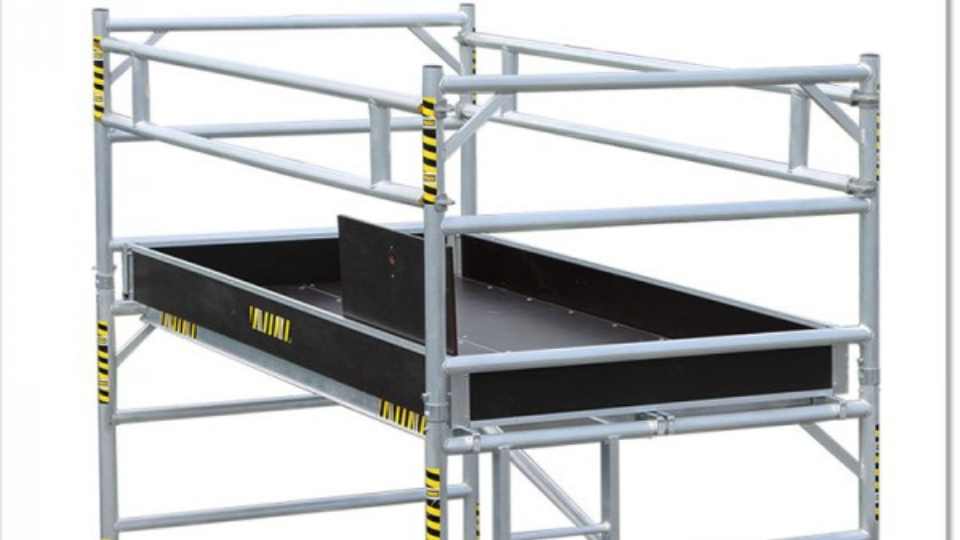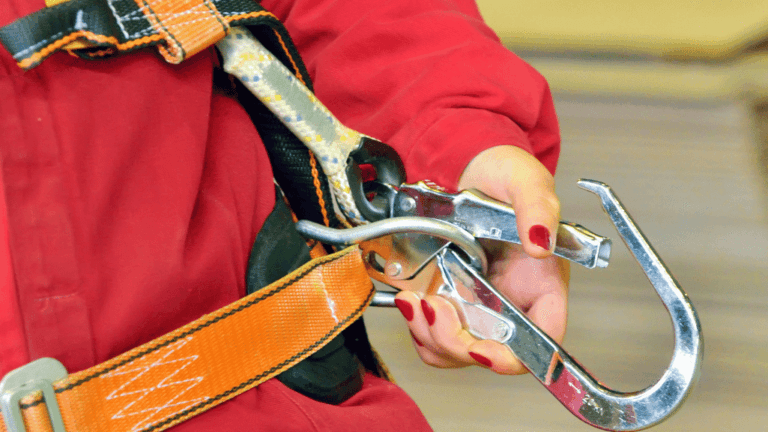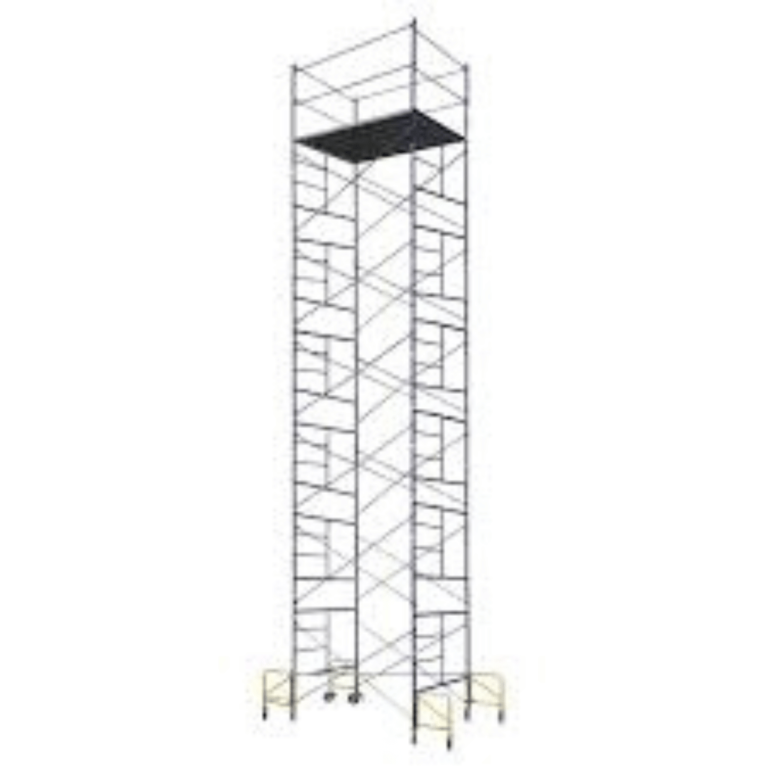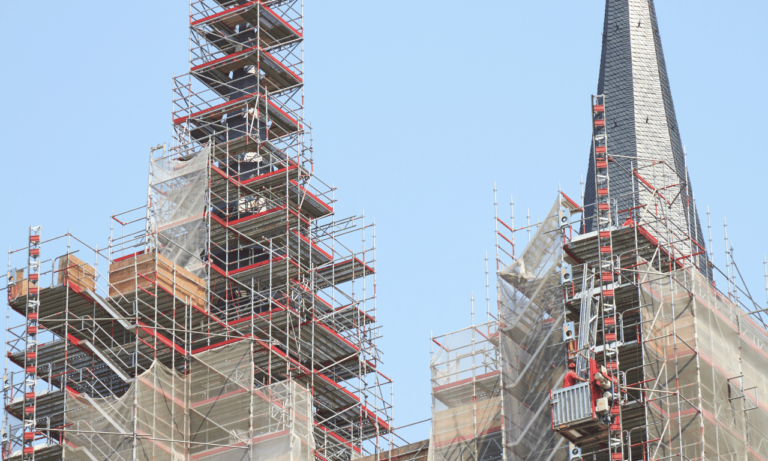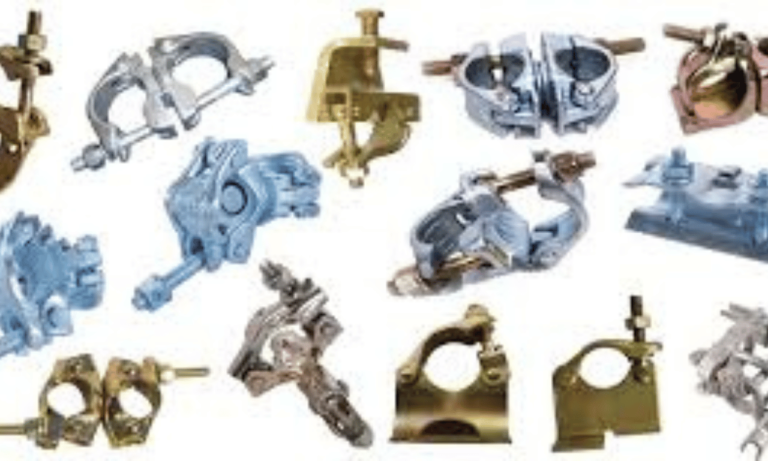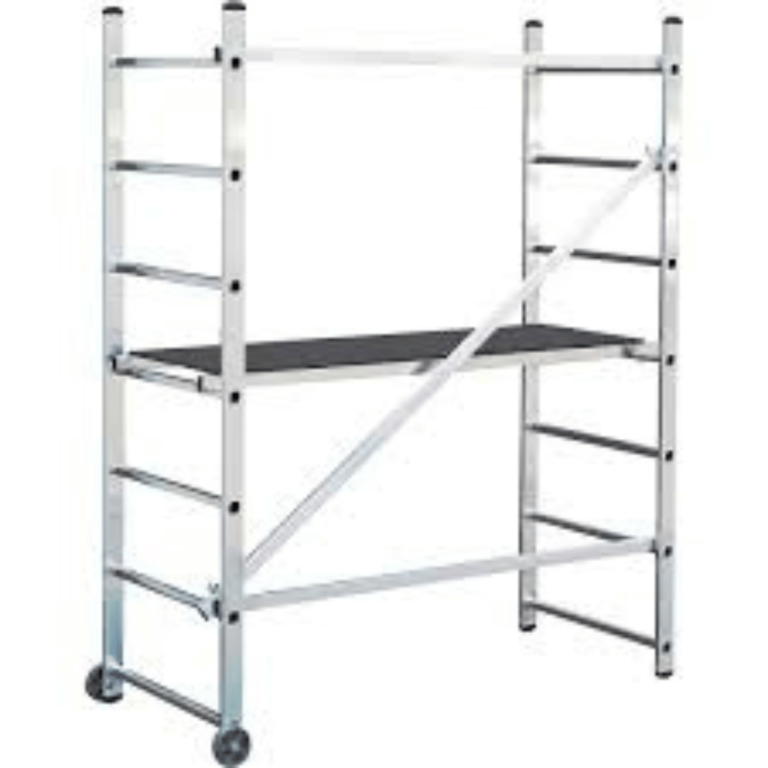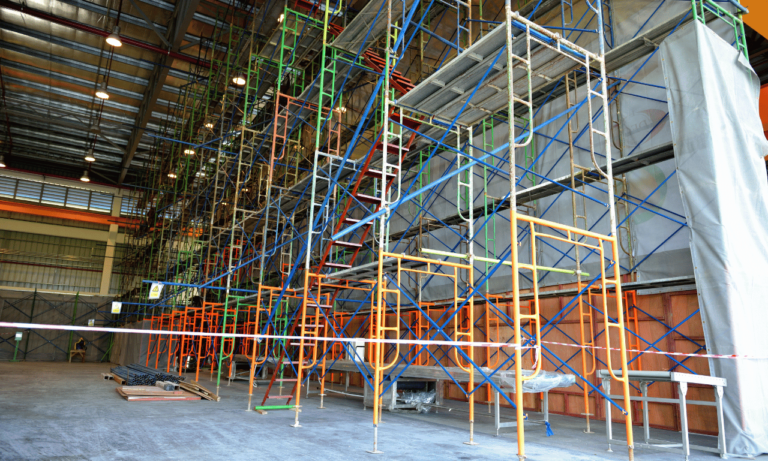Phone:
(+65)8319-0742
Welcome to our comprehensive guide on single scaffolding, an indispensable tool in the world of construction. Whether you’re a seasoned professional or new to the industry, understanding the ins and outs of scaffolding is crucial for the success and safety of your projects.
In this guide, we will explore the different types of scaffolding, the advantages of using single scaffolding, its components, safety measures, design considerations, platforms, and materials. By the end, you’ll be equipped with the knowledge needed to make informed decisions and ensure the smooth execution of your construction projects.
Key Takeaways:
- Single scaffolding is a vital component in construction and provides workers with safe access to elevated areas.
- Understanding the types of scaffolding available enables you to select the most suitable option for your project’s requirements.
- Knowing the components of single scaffolding, such as standards, ledgers, transoms, scaffold tubes, trestles, acrow props, boards, and fittings, ensures proper assembly.
- Implementing safety measures and adhering to regulations is of paramount importance when working with scaffolding to protect workers and prevent accidents.
- Choosing the right scaffolding system involves considering factors like the height of work, size of parts, ground support conditions, and duration of use.
Types of Scaffolding
When embarking on a construction project, it’s crucial to understand the different types of scaffolding available. Each type offers unique advantages and is suited to specific project requirements. Let’s explore three popular types: frame and brace scaffolding, suspended scaffolding, and ring and cup system scaffolding.
Frame and Brace Scaffolding
Frame and brace scaffolding is a versatile and cost-effective option for various construction projects. It consists of vertical frames and horizontal braces that provide stability and support. This type of scaffolding is widely used in both large-scale construction jobs and smaller renovations. Its modular design allows for easy assembly and adaptability to different work environments.
Suspended Scaffolding
Suspended scaffolding, as the name suggests, is designed to hang from above, providing access to different levels of a building or structure. This type of scaffolding is commonly used for exterior work, particularly on skyscrapers. It offers flexibility in reaching different heights and can accommodate multiple workers simultaneously. Suspended scaffolding is secured by sturdy ropes or cables, ensuring stability and safety while working at elevated levels.
Ring and Cup System Scaffolding
Ring and cup system scaffolding is known for its durability and suitability for complex projects in industrial, marine, and offshore environments. This type of scaffolding utilizes interconnected rings and cups that lock securely into place, forming a sturdy structure for workers. Its robust construction allows for heavy loads and provides a reliable support system in challenging working conditions.
Now that we’ve explored the three main types of scaffolding, let’s take a closer look at the components that make up single scaffolding in the next section.
Components of Single Scaffolding
In single scaffolding, several components work together to create a safe and sturdy structure. These components include standards, ledgers, transoms, scaffold tubes, trestles, acrow props, boards, and fittings.
Scaffold tubes are the vertical elements that form the main support system of the scaffolding. They are designed to provide stability and strength to the structure.
Boards are essential for creating stable working platforms for workers. They are placed horizontally across the scaffold tubes to provide a safe surface to stand on during construction or maintenance tasks.
Standards are the upright vertical pipes on which the scaffold tubes are fixed. They act as the primary load-bearing components of the scaffolding system.
Ledgers are horizontal pipes that connect the standards, providing additional support and stability to the scaffolding structure. They run parallel to the building or structure being worked on.
Transoms are the shorter horizontal pipes that connect the ledgers, reinforcing the scaffolding system further.
Trestles are used to support scaffold boards at a higher level. They provide additional support and stability to the working platforms, especially when working at greater heights.
Acrow props are adjustable vertical supports used to reinforce large scaffold structures. They provide temporary support, ensuring the scaffolding remains stable during construction or renovation work.
Fittings include various connectors, clamps, and couplers that are used to join the different components of the scaffolding system, ensuring a secure and reliable structure.
Single Scaffolding Components
| Component | Function |
|---|---|
| Standards | Vertical pipes providing primary support |
| Ledgers | Horizontal pipes connecting standards |
| Transoms | Shorter horizontal pipes reinforcing the scaffolding |
| Scaffold Tubes | Vertical elements forming the support system |
| Trestles | Supports for scaffold boards at higher levels |
| Acrow Props | Adjustable vertical supports for reinforcing large scaffolds |
| Boards | Horizontal platforms for workers |
| Fittings | Connectors, clamps, and couplers for joining components |
By understanding the purpose and function of each component, construction professionals can ensure the proper assembly and safe usage of single scaffolding systems.
Importance of Scaffolding Safety

When it comes to working with scaffolding, safety should always be the top priority. A strong emphasis on safety measures, adherence to safety regulations, utilization of proper safety equipment, and extensive safety training for workers are essential for a successful and accident-free construction project. By implementing the necessary precautions, you can minimize the risk of accidents and create a safe working environment for everyone involved.
To ensure scaffolding safety, it is important to follow established safety regulations set by regulatory bodies. These regulations outline the standards and guidelines for safe scaffolding practices, covering aspects such as weight limits, platform stability, and fall protection.
Aside from following safety regulations, providing workers with the right safety equipment is crucial. This includes items such as hard hats, safety harnesses, non-slip footwear, and high-visibility clothing. The proper use of safety equipment can significantly reduce the risk of falls, head injuries, and other accidents.
However, safety equipment alone is not enough. Adequate safety training is necessary to educate workers on how to use scaffolding safely and effectively. Safety training programs should cover topics such as the proper assembly and disassembly of scaffolding, the correct usage of safety equipment, and how to identify and mitigate potential hazards on the job site. By equipping workers with the knowledge and skills to navigate scaffolding safely, the likelihood of accidents will be greatly reduced.
Working closely with scaffolding companies is another crucial aspect of ensuring safety. These companies have extensive experience and expertise in scaffolding design, setup, and safety measures. By partnering with them, you can benefit from their knowledge and ensure that the scaffolding is installed correctly and meets all safety standards. They can also conduct regular inspections and maintenance to identify and address any potential safety risks.
Scaffolding safety must be a collective effort by all involved in the construction project. It requires a proactive approach, continuous communication, and a strong commitment to maintaining a safe working environment. By prioritizing safety, you can protect the well-being of workers, prevent accidents, and ensure the successful completion of your construction project.
Choosing the Right Scaffolding System
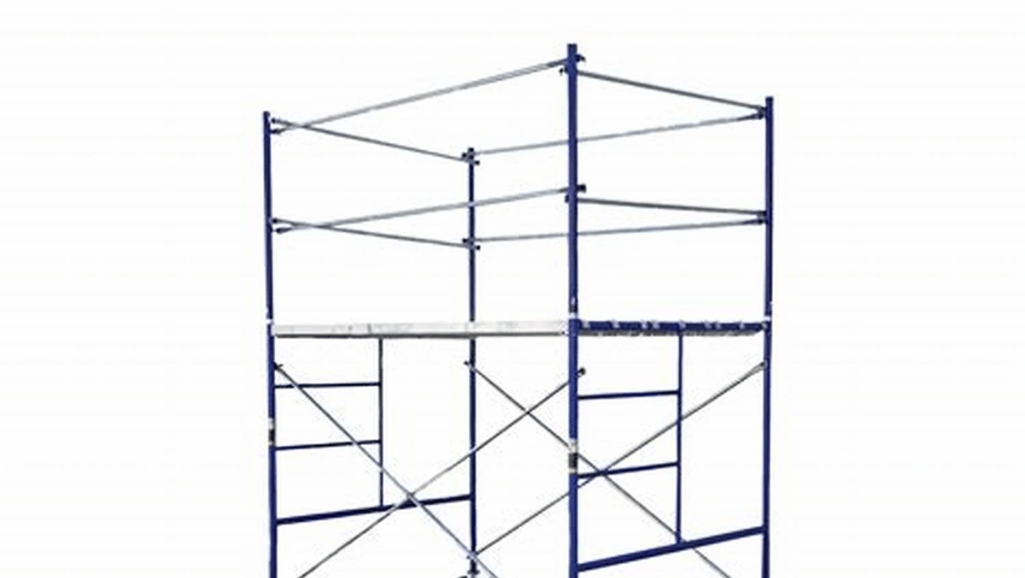
When it comes to selecting the ideal scaffolding system for your construction project, various factors need to be taken into consideration. These factors include the height of the work, the size of the parts required, ground support conditions, and the duration of use. Each of these elements plays a vital role in determining the most suitable scaffolding system that meets your project requirements.
The height of the work is a critical consideration. Depending on the scale of your project and the elevation at which work needs to be performed, you will need to choose a scaffolding system that can safely reach those heights. Whether it’s a single-story building or a high-rise construction, selecting the scaffolding system with the right height range is essential for worker safety and efficient functionality.
Another important factor to consider is the size of the parts needed. Different construction projects require specific component dimensions to ensure stability and durability. By carefully evaluating the size of the parts required, you can select a scaffolding system that accommodates these dimensions, providing the necessary support and functionality throughout the project.
Ground support conditions must also be taken into account when choosing a scaffolding system. The stability of the ground surrounding the construction site impacts the type of scaffolding that can be used. Unstable or uneven ground may require additional support measures or alternative scaffolding options to ensure the safety of workers and the structural integrity of the construction process.
Additionally, the duration of use should be factored in when selecting a scaffolding system. Some projects require long-term scaffolding solutions, while others may only need temporary structures. By determining the duration of use, you can choose a scaffolding system that offers the appropriate level of durability and ease of assembly and disassembly, optimizing both time and resources.
Overall, selecting the right scaffolding system involves a comprehensive evaluation of project requirements, including the height of the work, the size of the parts needed, ground support conditions, and the duration of use. By considering these factors, you can make an informed decision and choose a scaffolding system that provides a safe and efficient working environment for your construction project.
Planning and Installation

Proper planning and installation of scaffolding are crucial for the success and safety of construction projects. By considering factors such as the planning scaffolding layout, weight-bearing capacity, installation by professionals, and foundation support, you can ensure a stable and secure scaffolding structure.
When planning the scaffolding layout, it is important to assess the specific requirements of the project. Take into account the dimensions and shape of the structure being worked on, as well as any obstacles or constraints that may impact the scaffolding design. This careful consideration will help optimize the scaffolding setup and streamline construction processes.
The weight-bearing capacity of the scaffolding is another crucial factor to consider. Determining the maximum load the scaffolding needs to support is essential for selecting the appropriate components and ensuring structural integrity. Adhering to weight limits is vital for the safety and stability of the scaffolding system.
While some individuals may be tempted to undertake scaffolding installation themselves, it is highly recommended to hire professionals for this task. Trained and experienced scaffolding installers have the necessary expertise to construct a secure and stable structure. They understand the specific requirements and safety measures involved in the installation process, reducing the risk of accidents and ensuring compliance with industry standards.
Foundation support is a critical aspect of scaffolding installation. The scaffold base needs to be properly supported by the ground or other surfaces to maintain stability. The ground conditions, such as soil type and firmness, should be assessed to determine the appropriate foundation support, such as base plates or sole boards. This support helps distribute the weight of the scaffolding and prevents sinking or shifting.
By prioritizing planning scaffolding layout, weight-bearing capacity, installation by professionals, and foundation support, you can ensure the safety, stability, and efficiency of your scaffolding system. Investing in well-designed and properly installed scaffolding will contribute to the overall success of your construction project.
Practical Experience and Training
When it comes to scaffolding, practical experience is invaluable for gaining the necessary skills and building confidence in this field. While formal training is essential, it is the combination of training and hands-on experience that truly enhances knowledge and ability in scaffolding construction.
Practical experience provides an opportunity to apply the theoretical knowledge gained from training in real-world scenarios. It allows scaffolders to understand the challenges and complexities that may arise on the job site, offering valuable insights and problem-solving capabilities. Working with different types of scaffolding systems and components in various construction projects helps develop versatility and adaptability.
Continuous learning is also crucial in the scaffolding industry. With advancements in technology, regulations, and techniques, it is essential for scaffolders to stay up-to-date. By actively seeking opportunities for professional development and staying informed about industry changes, scaffolders can maintain their competitive edge.
Training programs and courses play a vital role in scaffolding education, equipping individuals with the fundamental knowledge and safety practices necessary for the job. However, it is the practical experience gained through on-the-job training that solidifies this knowledge and enables scaffolders to become proficient in their craft.
Furthermore, continuous learning goes beyond initial training. It involves actively engaging in ongoing education, attending workshops, conferences, and seminars, and staying informed about the latest industry trends and best practices. By dedicating time and effort to continuous learning, scaffolders can constantly refine their skills and stay ahead in the ever-evolving construction landscape.
Benefits of Practical Experience and Continuous Learning
There are several benefits to gaining practical experience and embracing continuous learning in the scaffolding industry:
- Enhanced problem-solving skills: Practical experience allows scaffolders to encounter and overcome challenges, improving their problem-solving abilities on the job.
- Increased confidence: The more practical experience a scaffolder gains, the more confident they become in their abilities to construct and dismantle scaffolding safely and efficiently.
- Efficiency and productivity: With practical experience and continuous learning, scaffolders can optimize their workflow, leading to increased productivity and efficiency.
- Improved safety: By incorporating continuous learning into their practice, scaffolders stay informed about the latest safety regulations and best practices, ensuring a safe working environment.
- Versatility and adaptability: Practical experience with different scaffolding systems and materials enables scaffolders to adapt to various project requirements and work environments.
By combining practical experience with continuous learning, scaffolders can hone their skills, advance in their careers, and contribute to the successful completion of construction projects.
| Benefits of Practical Experience | Benefits of Continuous Learning |
|---|---|
| Enhanced problem-solving skills | Opportunity to stay informed about industry advancements |
| Increased confidence | Improved safety practices |
| Efficiency and productivity | Professional development and career progression |
| Improved safety | Flexibility and adaptability in the construction industry |
| Versatility and adaptability |
Advancements and Career Progression
As you gain experience and expertise in the scaffolding industry, it’s essential to continue your professional development through advanced scaffolding courses and explore opportunities for career progression. These avenues allow you to refine your skills, deepen your knowledge, and take on higher responsibilities in scaffolding projects.
Advanced Scaffolding Courses
Investing in advanced scaffolding courses can significantly enhance your capabilities and open doors to new opportunities. These courses provide specialized training in areas such as advanced scaffolding techniques, complex scaffold designs, safety management, and project coordination.
By acquiring advanced knowledge through these courses, you not only improve your skillset but also gain a competitive edge in the industry. Employers value individuals who continually seek to enhance their expertise and stay updated with the latest advancements.
Career Progression
Career progression in scaffolding is directly linked to your skill level and experience. As you expand your knowledge and gain practical expertise, you become eligible for higher-level positions that require more complex scaffolding projects.
Advancing in your career may involve transitioning from an entry-level scaffolder to a team leader or supervisor role. In these positions, you will be responsible for overseeing the scaffolding process, coordinating with project managers and other professionals, and ensuring the successful completion of projects.
Moreover, career progression may also involve exploring management roles, where you can leverage your expertise to lead teams, develop strategies, and contribute to the overall growth of scaffolding operations within a company.
Continuing Education and Specializations
In addition to advanced scaffolding courses, it’s crucial to stay current with industry trends, new regulations, and emerging technologies. Continuous learning and adaptation are integral to success in the scaffolding field.
Consider attending seminars, workshops, and conferences to gain insights from experts and stay updated with the latest industry developments. Refresher courses can also help reinforce your existing knowledge and ensure compliance with safety regulations.
Furthermore, specializing in specific areas of scaffolding, such as offshore scaffolding or industrial scaffolding, can provide further career opportunities and expertise in niche sectors. By becoming a subject matter expert in a particular field, you can differentiate yourself and access more challenging projects.
| Benefits of Advanced Scaffolding Courses and Career Progression | How They Contribute to Success in Scaffolding |
|---|---|
| 1. Enhanced skills and knowledge | 1. Ability to tackle complex scaffolding projects |
| 2. Increased earning potential | 2. Access to higher-paying positions and project opportunities |
| 3. Competitive advantage | 3. Stand out among other scaffolders and secure desirable positions |
| 4. Expanded career options | 4. Transition into leadership roles and explore management opportunities |
Continuing to invest in your professional growth through advanced scaffolding courses and exploring career progression opportunities will pave the way for a successful and fulfilling scaffolding career. By consistently expanding your knowledge and skills, you can stay at the forefront of the industry and achieve the career milestones you aspire to.
Continuous Learning and Adaptation
The scaffolding industry is a dynamic field that constantly introduces new techniques, regulations, and technologies. To stay current in the scaffolding industry, professionals need to prioritize continuous learning and adapt to the changing landscape.
By actively seeking out new information, professionals can discover innovative approaches and improve their efficiency in scaffolding projects. Keeping up with industry best practices and emerging trends ensures that their skills and knowledge remain relevant and valuable.
One way to stay current is by attending refresher courses. These courses provide the opportunity to refresh existing knowledge, learn new techniques, and understand the latest regulations that govern scaffolding safety. Refresher courses help professionals develop a comprehensive understanding of industry standards, enabling them to execute projects safely and efficiently.
Moreover, professionals can also join industry associations and attend conferences and seminars. These events provide valuable networking opportunities, allowing individuals to exchange ideas, learn from industry experts, and gain insights into the latest technologies that can enhance scaffolding operations.
Another approach to staying current is by actively engaging with online resources such as industry blogs, forums, and publications. These platforms offer valuable insights, case studies, and discussions that shed light on current industry practices and technological advancements. By actively participating in online communities, professionals can exchange knowledge with their peers and stay up-to-date with the latest developments in the field.
Evolving Regulations
Regulations governing the scaffolding industry continually evolve to ensure the safety and well-being of workers. Staying informed about regulatory changes is crucial for scaffolding professionals to adhere to compliance standards and maintain safe working environments.
By regularly checking regulatory websites and consulting with industry experts, professionals can remain up-to-date with the latest regulations. It’s essential to understand any revisions or additions to existing guidelines to ensure compliance and minimize potential risks.
The integration of technology in scaffolding has also revolutionized the industry, enhancing both safety and efficiency. Professionals should be aware of the latest technological advancements, such as digital planning tools, remote monitoring systems, and advanced scaffold inspection equipment. Staying informed about these technologies allows professionals to leverage their benefits and keep their scaffolding operations at the forefront of industry standards.
Continuous learning and adaptation are vital for scaffolding professionals to thrive in this ever-evolving industry. By staying current with new techniques, regulations, and technologies, professionals can enhance their skills, improve project outcomes, and ensure the safety of their teams.
Keep looking forward to the future, stay curious, and be proactive in your pursuit of knowledge and growth in the scaffolding industry.
Seeking Guidance from Experts
Embarking on a career in scaffolding can be both exciting and challenging. Throughout your journey, it’s important to remember that you don’t have to navigate this path alone. Seeking advice in scaffolding and reaching out to industry experts can provide valuable insights and support to help you succeed.
Industry experts have years of experience and expertise in scaffolding, making them an invaluable resource for guidance and mentorship. Whether you have questions about specific scaffolding techniques, safety measures, or career progression, reaching out to these experts can provide you with the answers you need.
When seeking advice in scaffolding, it’s important to approach industry experts with respect and a willingness to learn. Start by identifying professionals who have a strong reputation and background in the scaffolding industry. Research their work, read their articles or publications, and familiarize yourself with their expertise.
There are several ways to reach out to industry experts, including attending industry conferences, trade shows, and networking events. These events provide excellent opportunities to connect with experts in the field, ask questions, and gain valuable insights into the industry.
In addition to in-person events, you can also seek guidance from experts through online platforms such as forums, industry-specific websites, and social media groups. These platforms allow you to connect with experts from around the world, expanding your network and opening doors to new opportunities.
Remember, seeking advice from industry experts is not a sign of weakness but rather a demonstration of your commitment to growth and improvement. By leveraging the knowledge and experience of these experts, you can enhance your skills, make informed decisions, and accelerate your career in scaffolding.
Scaffolding Expert Spotlight: Jane Collins
One industry expert who has made significant contributions to the field of scaffolding is Jane Collins. With over 20 years of experience in the industry, Jane has worked on numerous high-profile construction projects, providing expert advice and guidance to professionals in the field.
As the founder of Collins Scaffolding Solutions, Jane has established herself as a trusted authority in scaffolding design, safety measures, and best practices. Her dedication to quality and innovation has earned her recognition from both peers and clients alike.
For those seeking guidance in their scaffolding journey, Jane’s expertise and insights can prove invaluable. Whether you have questions about scaffold design, choosing the right components, or improving safety measures, Jane’s experience can provide you with the knowledge and confidence to excel.
Top Industry Experts in Scaffolding
| Name | Company | Expertise |
|---|---|---|
| John Smith | Smith Scaffolding Services | Scaffolding design, construction, and safety |
| Sarah Johnson | Johnson Scaffolding Solutions | Industry regulations and compliance |
| Michael Thompson | Thompson Scaffold Systems | Advanced scaffolding techniques and innovation |
Conclusion
Embarking on a career in scaffolding requires a thorough understanding of the essentials and undergoing proper training. Single scaffolding is a crucial component in construction projects that involve working at significant heights. By familiarizing yourself with the different types of scaffolding, understanding the components, and prioritizing safety measures, you can ensure the success and longevity of your scaffolding projects.
Choosing the right scaffolding system is essential for the efficiency and safety of your work. Consider factors such as the height of the project, the size of the parts needed, the ground support conditions, and the duration of use when selecting the most appropriate scaffolding system.
Continuous learning is key in the scaffolding industry. Stay current with new techniques, regulations, and technologies by attending refresher courses and seeking guidance from industry experts. Advancing in your scaffolding career is possible through specialized courses and career progression opportunities.
With dedication to continuous improvement and a commitment to safety, you can build a successful and fulfilling career in the scaffolding industry. Embrace the challenges, refine your skills, and stay up-to-date with industry advancements to excel in your scaffolding journey.
FAQ
What is single scaffolding?
Single scaffolding is a type of scaffolding used in construction projects that involve scaling high levels. It consists of vertical standards, ledgers, transoms, scaffold tubes, trestles, acrow props, boards, and fittings.
What are the advantages of using single scaffolding?
Single scaffolding provides a stable support system for workers, allowing them to work at heights safely. It is also cost-effective and easy to assemble. Additionally, it can be used in various types of construction projects.
What are the components of single scaffolding?
The components of single scaffolding include standards (vertical poles), ledgers (horizontal bars), transoms (horizontal beams), scaffold tubes, trestles (support frames), acrow props (temporary vertical supports), boards (platforms), and fittings (connecting elements).
What safety measures should be taken when working with scaffolding?
When working with scaffolding, it is important to follow safety regulations, use proper safety equipment (such as helmets and harnesses), and provide safety training for workers. Scaffolding companies can assist in ensuring correct setup and implementation of safety measures.
How do I choose the right scaffolding system for my project?
When selecting a scaffolding system, consider factors such as the height of the work, the size of the parts needed, the ground support conditions, and the duration of use. Different scaffolding systems are suitable for different project requirements.
What should I consider during the planning and installation of scaffolding?
During the planning and installation of scaffolding, consider the layout, weight-bearing capacity, and support conditions. It is recommended to hire professionals for the installation to ensure safety and proper construction.
How important is practical experience and training in scaffolding?
Practical experience in scaffolding is invaluable for gaining skills and confidence. Alongside training, it enhances knowledge and ability in scaffolding construction. Continuous learning is important to stay up-to-date with industry advancements.
How can I advance in the scaffolding industry?
Advancement in the scaffolding industry is possible through specialized courses and career progression. Advanced scaffolding courses provide opportunities to refine skills and take on higher responsibilities in scaffolding projects.
How do I stay current in the scaffolding industry?
The scaffolding industry is constantly evolving with new techniques, regulations, and technologies. Staying current through continuous learning and attending refresher courses ensures that skills and knowledge are up-to-date.
Where can I seek guidance in my scaffolding journey?
If you have questions or need guidance in your scaffolding journey, don’t hesitate to reach out to industry experts. They can provide valuable insights and support throughout your career.
How do I embark on a career in scaffolding?
Embarking on a career in scaffolding requires understanding the essentials and undergoing proper training. By following the necessary steps and continuously improving your skills, you can build a successful and fulfilling career in the scaffolding industry.

